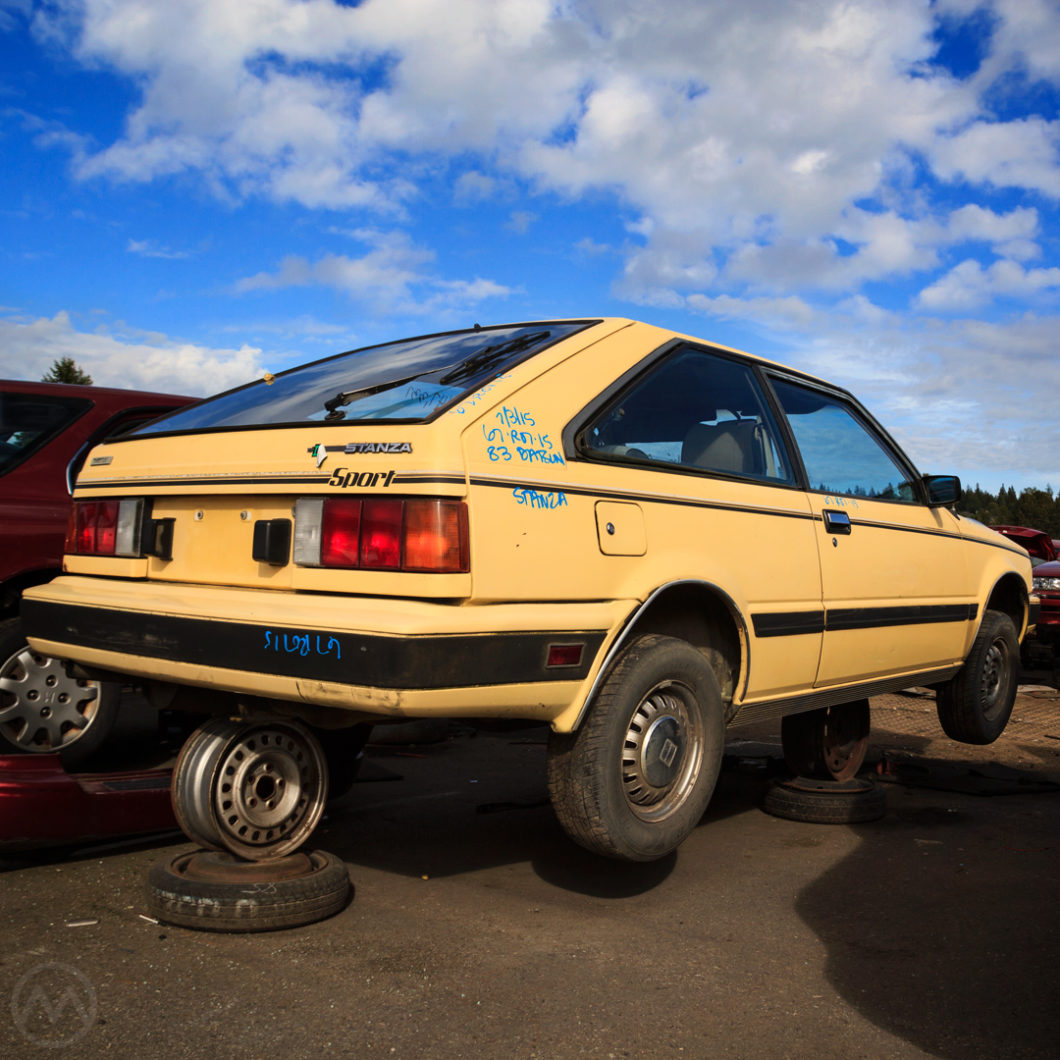First things first. 1. “Sport” is definitely a misnomer here. 2. No, you can’t save this yellow car, these are old photos and this car has long since shuffled off to beer-can land. Too bad though. From the “rare but not valuable” files comes this 1983 Nissan Stanza XE, complete with dealer-installed “Sport” stripes.
All of these early Stanzas are rare now, but especially the 3-door hatches, and this is the only one we’ve ever seen that looked quite like this.
It says Datsun on the side, yes, but the original Stanza was actually the first U.S. model to wear Nissan badges. In 1982-83 it actually wore both. On the left side there was a big Datsun badge, on the right side they said “Nissan Stanza,” though on our yellow subject car, the “Nissan” part had been broken off.
The transition from Datsun to Nissan, ordered by the company’s Japanese management, may or may not have hampered the Stanza’s launch. Just quite how customers viewed the two new names – “Nissan” and “Stanza” – isn’t entirely clear. What’s more discernible is the ire of Datsun dealers, who agonized over the re-brand and roundly detested spending tons of money remaking their stores, but more on that later.
The Stanza’s formula was basically right. Americans were lapping up cars just like it from American and Japanese manufacturers. Just two years later Toyota would use a very similar recipe to create the king of mainstream front-drive sedans, the Camry.
For a variety of reasons, however, the Stanza failed to resonate, and once-surging Datsun became also-ran Nissan in its segment. Nissan’s internal culture had a great deal to do with that, as we’ll see.
The First Stanza
When the T11-series Stanza first appeared in late 1981, it seemed at first glance like a total reinvention of Datsun’s mainstream small family cars.
The new car was a Euro-style front driver that came as a 3- or 5-door hatch. To Americans it bore little resemblance to previous Datsuns. It looked nothing like its immediate predecessor – the rear-drive 510, nor did it resemble it’s only front-wheel drive sibling at the time, the 310. In practice, this “radically new” car was about as conservative as possible for something so new.
In Japan, these cars had other names and more distinct histories.
The Stanza was also sold under the long-running Violet name, and as the Nissan Auster through Nissan’s array of dealer networks. All three names had been introduced in 1977-78 on the previous-generation Violet, design code A10, which used the 510 name in the USA.
Using that name was an attempt to cash-in on the popularity of the original 510 of the late 1960s, but customers never got as excited about this latter-day 510 as they had the original. That was mainly because while the Violet/510 looked a bit like the BMW-challenging old 510, it didn’t drive like it – and it was not an exciting or interesting car from the average driver’s perspective.
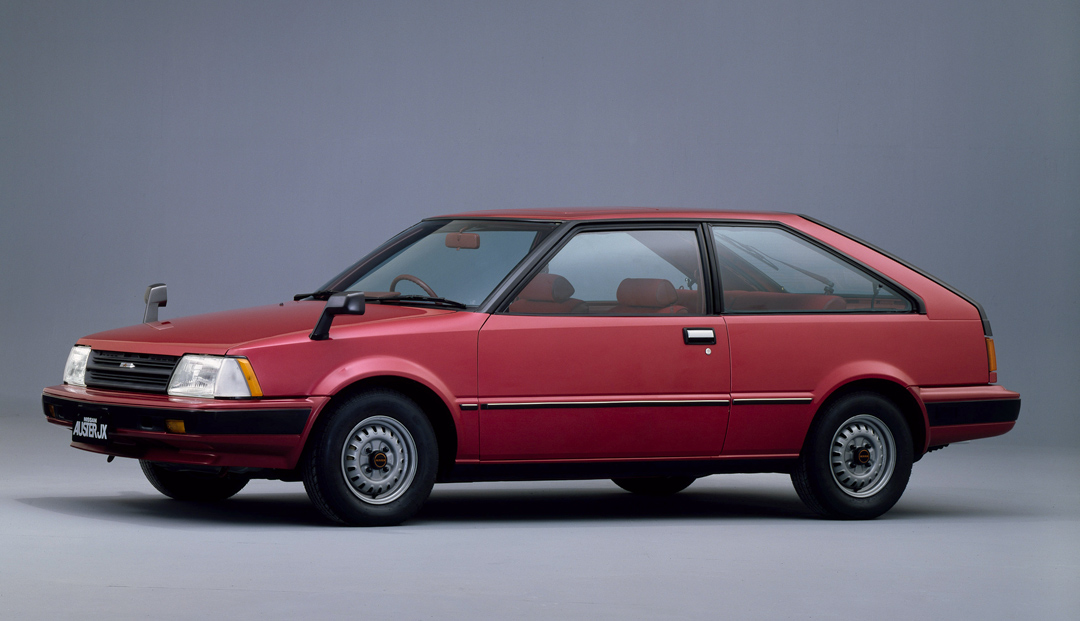
Nissan had begun going front-drive before all of its competitors except for Honda, and the 310 was called the Cherry at home and in most other markets. The Cherry, designed mostly by the Prince Motor Company, which merged with Nissan in 1966, first appeared in 1970.
It was a good seller in some export markets early on, particularly the U.K. and France. But Nissan never really did anything more with it. The Cherry grew into a second and third generation, but Nissan did not expand its front-drive lineup and the rather odd looking Mk2 Cherry never established the kind of market presence Honda had with the Civic. During the 1970s other manufacturers took the lead – particularly Honda.
The T11 Stanza was directly inspired by the success of Honda’s Accord, which had cut deep into sales of the rear-drive Violet/510 on both sides of the Pacific. When the Stanza appeared it used all the latest new ideas – lightweight construction, front drive with a transverse engine, McPherson struts on each corner, but wasn’t exciting to drive or look at. Nobody ever took direct credit for designing it,
The Squeaky Wheel Gets Removed
Part of the problem was Nissan’s risk-averse, insular bureaucracy, which had grown with the company as it expanded in the 1960s and 1970s.
Employees were discouraged from owning anything other than a Nissan, for example. This was the same kind of insularity that got Detroit in trouble in the 1980s. But even in the 1960s and 1970s, execs who innovated, took chances, and didn’t kowtow to management in the right way got in trouble.
Consider the case of Yutaka Katayama, father of the 510 and the Z and instrumental in creating Nissan’s U.S. operation. He was at first exiled to America for boosting Nissan’s profile in Australia through racing and for being unenthusiastic about Nissan’s new management-sponsored Union.
Once in America, he was repeatedly undercut or fought by execs in Japan on almost every request he made, and rarely given credit for his huge successes until after he’d retired. He gave as good as he got – often criticizing Japanese managers who came to America and only associated with other Japanese, refusing to bother with getting to know Americans or locals in other export markets.
One of his few allies in Japan was former export manager Takashi Ishihara, but even then they had a contentious relationship.
Charismatic and often blunt, CEO Ishihara (a Nissan man since 1937) had assumed the helm that same year, but he was often autocratic, with little regard for dissent within the ranks. That was pretty normal for Japanese CEOs, but his product decisions were usually on the conservative side even if his production decisions weren’t. It was Ishihara’s idea to build factories in America and the United Kingdom.
But he’d also inherited a major problem: Union boss Ichiro Shioji. Shioji had been a key part of the “management sponsored union,” and ran it by the early 1960s. He was an ally of longtime Nissan CEO Katsuji Kawamata.
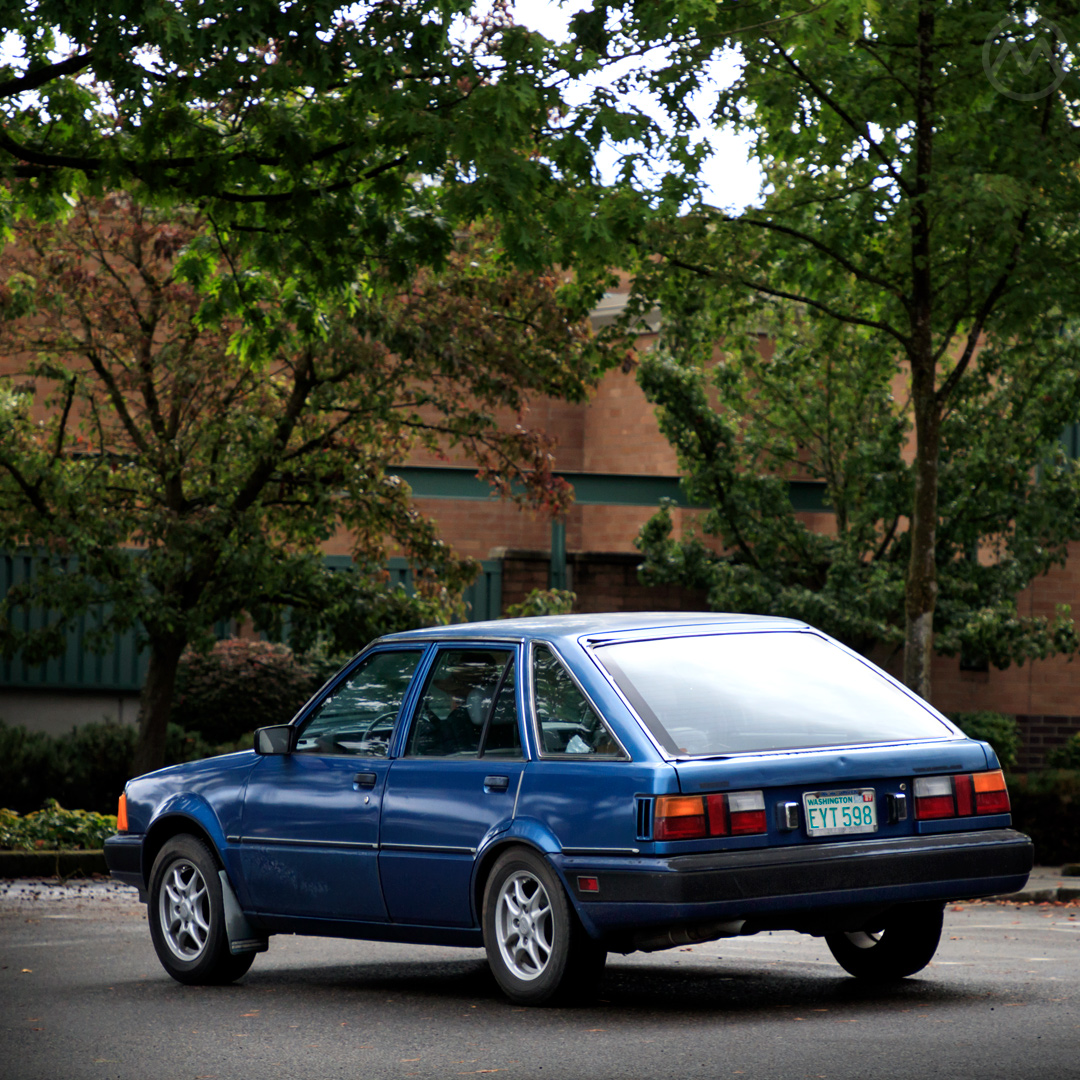
Shioji steered the unions away from militancy in the 1950s and put out all sorts of labor fires for Kawamata over the years. It was Shioji who made sure Prince’s union employees were easily absorbed into Nissan. He used patronage and intimidation to make his trains run on time, he was a tyrant in his position – stifling attempts at modernization and ruthlessly controlling underlings, factory administrators, and suppliers.
Katayama did not like Shioji and refused to kiss up to him, and that’s one reason he was eventually recalled to Japan. Shioji once engineered the downfall of Nissan’s Australian sales manager, who was sentenced to a tiny subsidiary firm in Japan in retaliation for a perceived slight.
Once Ishihara took the helm, some things got better, but the bloated size of Nissan’s corporate management meant real change was difficult, and every change had to have the blessing of Shioji. Aside from specialty cars like the Z and the new-for-1980 Leopard, Nissan’s product and marketing decisions in this period were decidedly less than adventurous.
That showed in market share. Nissan sales declined from 34% of the JDM market to 27% from 1974 to 1982. The sales were mostly lost to Honda. Which is why, in 1978-79, Nissan started taking cues from Honda for two new cars – the forthcoming Stanza/Auster/Violet and the Sunny, to come shortly after.
Ishihara also embarked on plans for factories in the USA and United Kingdom – he had Shioji’s blessing on the former, possibly because of Shioji’s friendship with UAW leaders, but the two fought bitterly on the latter.
The Stanza Goes Wanting
The new Stanza arrived in the fall of 1981, definitely the right time for a small, economical front-drive hatch, but somehow, it did not seem to resonate.
At home the Auster/Stanza/Violet got a range of engines from 90 to 110hp. Most were fairly pedestrian, but the Auster GT-EX 3-door did a passable impersonation of a VW-Scirocco style coupe even if it didn’t quite have the VW’s moves. The cars were the largest front-drive machine Nissan had yet built, and equal in size to the 910-series Bluebird introduced in 1979.
Just in case people hated the Stanza, the Bluebird was still there to offer a much more conventional car, but the front-driver looked promising at home.
In America, however, the cars got only an 88-hp 2-liter and 250 extra lbs. thanks to big bumpers and structural reinforcement. The suspensions were turned for comfort, not sharpness. There was little pretense of “sport.”
In fairness, that’s what American customers wanted. Just two years after the Stanza was introduced, Toyota would drop the Camry and never look back – but somehow the Camry’s formula gelled where the Stanza’s did not. Americans preferred Accords or GM’s then-new J-cars (Chevy Cavalier, Pontiac J2000, etc.). Soon they’d also be buying Ford Tempos and Toyota Camrys. Even the Mazda 626 outsold it.
Nor did it find much love in Japan, where, as some insiders had thought, the 910-series Bluebird continued to outsell it. That’s not to say it was a bad car – it was reliable death and taxes, just not very exciting or interesting. It was an appliance.
Nissan’s name change may also have hurt the Stanza’s launch, as customers struggled to understand the new name despite a major marketing blitz. Both the Nissan and the Stanza names were new, and they’d gotten to know many new Japanese brands in the previous decade. Both Isuzu and Mitsubishi were launching their U.S. networks at the time, and heavily promoting them.
Datsun Vs. Nissan, Ishihara Vs. Shioji
The Stanza may have been an ambitious idea to combat Honda, but Ishihara’s most ambitious plans were production related. Ishihara saw that expansion of production into the United States and United Kingdom would help Nissan become a truly global player.
To finance those plans, and specifically to get Nissan’s U.K. manufacturing base at Sunderland built, Ishihara wanted more people to know the Nissan name. That’s where the root idea for changing the name came from. Ishihara ruled by decree, and starting in 1982, the name would be changed from Datsun to Nissan worldwide, on all products. Gradually, but with the change to be completed by 1984.
Nissan’s American and Canadian dealers absolutely hated this idea – and so did many Japanese executives. Nissan’s U.S. boss at the time, Tetsuo Arakawa, openly pushed back against the concept, arguing that nobody needed to know the Nissan name and that throwing away Datsun would be costly and counterproductive.
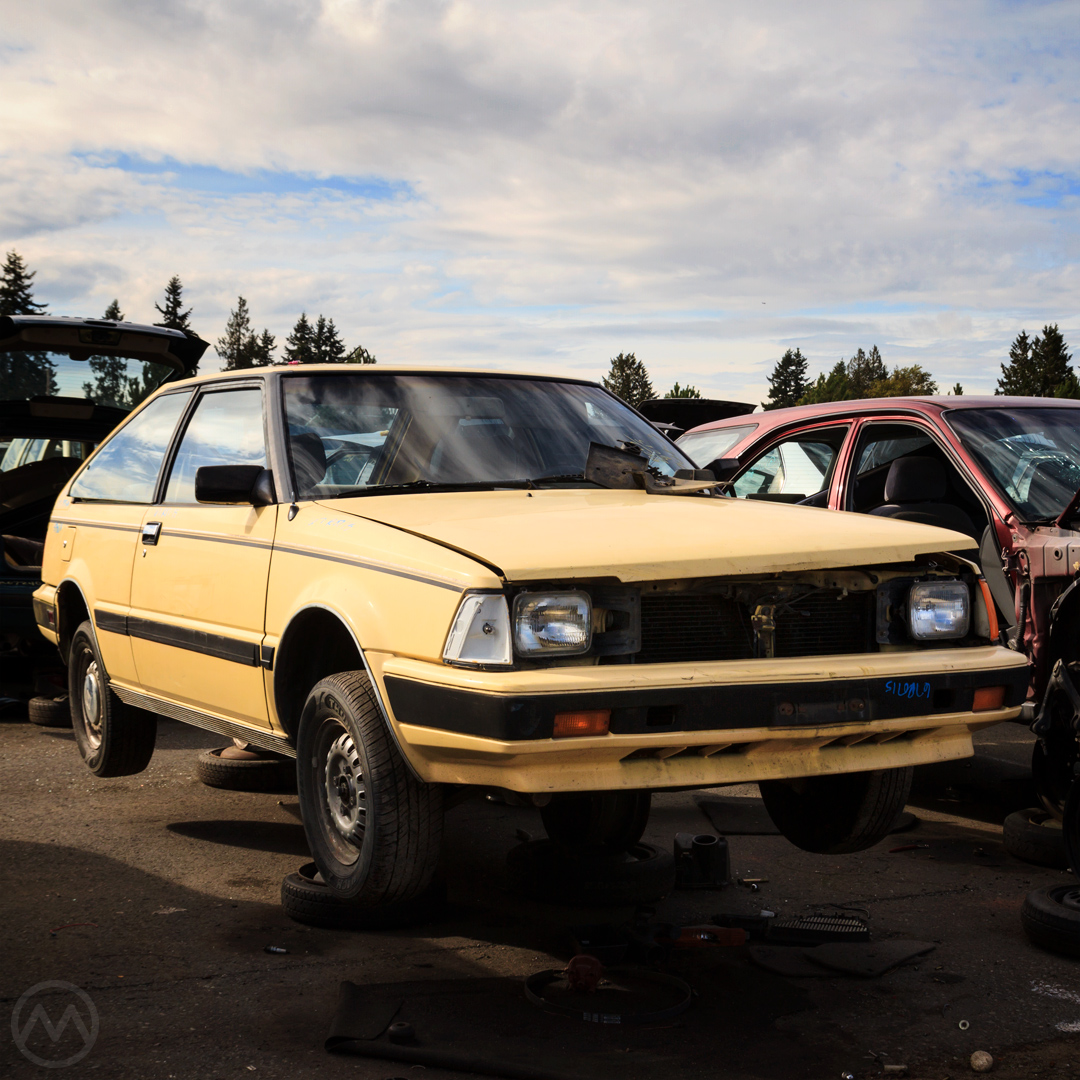
It did, in fact, add more than $100M in costs in the first two years alone to Nissan’s U.S. promotion budget, and untold amounts spent remodeling dealerships. But Ishihara was the boss, and there was little use in protesting.
The only person who could get in the way was Shioji, who didn’t care about the name change but did care about the U.K. factory, or rather, he cared about preventing it from happening.
Shioji was well acquainted with the American UAW management and even though Nissan’s American plant would be non-union, he recognized how valuable the American market was. Ishihara would not budge on that plan, and so it went ahead.
But when it came to Nissan’s U.K. venture, Shioji went to great lengths to scuttle the project. He had his own feasibility studies done and, in the end, resorted to work stoppages, slowdowns, and even sabotaging new manufacturing equipment. Shioji went so far as to come into conflict with Japanese PM Yasuhiro Nakasone, who very much wanted the U.K. deal to go forward and had worked directly with the Thatcher government to ensure it would.
Private criticism of management within a company was one thing, but Shioji had gone beyond the pale. He ultimately lost the Sunderland fight, and was soon to get his comeuppance. Many Nissan managers – even union subordinates – had long disdained Shioji’s influence, and some began privately working to oust him.
Some months after he’d publicly sparred with Ishihara on the Sunderland issue, Shioji was caught on camera partying with young ladies on a yacht he’d mysteriously acquired (on his official Union salary) and had corporate employees crewing. Seven section managers within the company, they called themselves the Seven Samurai, had tipped off the Japanese tabloid Focus to his whereabouts.
He immediately lost his political capital and was gone by 1986. By then Ishihara himself – not a young man – had stepped down; openly noting that he’d spent up to 70% of his time in his final years on the job fighting with Shioji and trying to reign him in.
The person who took over for Ishihara was Yutaka Kume, who had been involved with the development of both the Stanza and the first front-drive Sunny, better known to Americans as the Sentra. He had just completed overseeing the creation of the T12 Stanza – which would be the first car built at Sunderland – when he took on the CEO role.
Kume swept away the old order and with Shioji out of the way made many reforms to the company culture. He cut back staff, he reshuffled executives, he rededicated the staff to making more interesting products. The first fruits of his labor were seen in the Nissan Be-1 and other boutique cars. By the late 1980s Nissan was resurgent with new products and making a real comeback.
But that’s another story. In the meantime…
The Stanza XE
There was no such thing as a “Stanza Sport.” Instead, our junkyard subject car was a Stanza XE – the “loaded” version of the car and a $1020 option that you needed to buy to get air conditioning. The basic Stanzas were basic indeed – and the rare 3-doors tended to be absolute strippers or loaded to the gills with little extras.
The “Sport” graphics actually make this car look the part of a Scirocco or Fuego competitor, although nobody would have thought of the Stanza that way at the time. It was all about being a family car, and in 1983 Nissan added a 4-door notchback sedan which quickly became the best-selling U.S. Stanza (Europeans preferred the 5-door). The notch had already been on sale in Japan.
Buyers in Dats-er, Nissan, showrooms had several sporty options to choose from at the time, and the Stanza 3-door was not usually on their list.
1983 was an unusually good year for 2-door choices. The appreciably more sporty 200SX (aka Silvia) was about the same price as the Stanza XE, while the smaller Sentra hatchback was lighter and a better performer while looking pretty similar. The Stanza did not resonate with customers but the Sentra definitely did.
There were also the NX Pulsar and a Pulsar hatch. The angular NX coupe would continue for many more years, but the hatches, popular in Europe as the Nissan Cherry, were offered for just a few months in the USA.
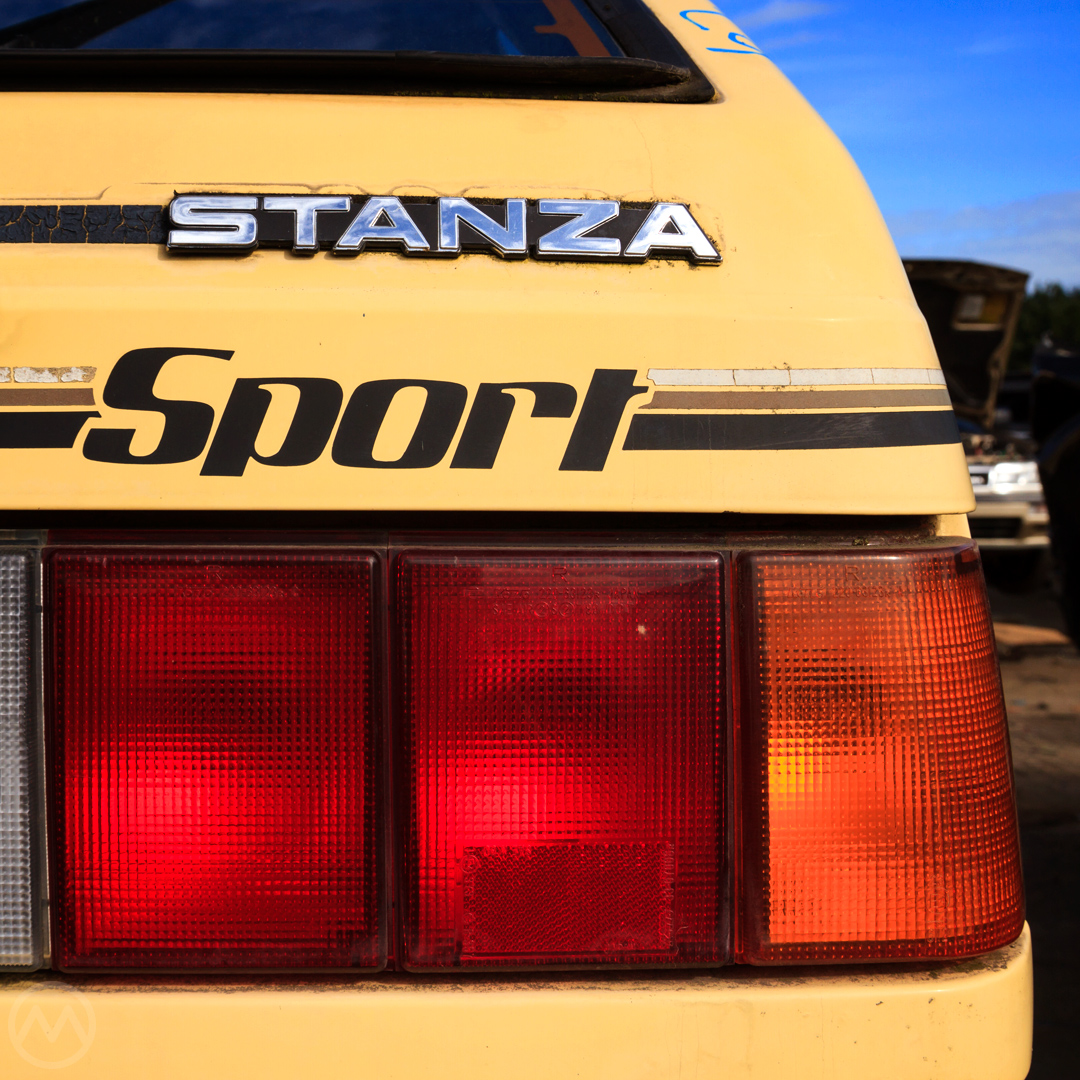
As such, the 3-door Stanza found very few takers – probably only 8-10 percent of sales, or about 4-6K cars a year. The slow-selling 3-door was dropped at the end of 1984, while the 5-door continued one more year before it too was gone. Nissan also marketed the Prairie “tall car,” really more of a Minivan, as part of the Stanza line at the time.
Just as Yutaka Kume’s changes were beginning to be felt in Japan, the second-gen front-drive Stanza, the T12-series, debuted globally in late 1986.

